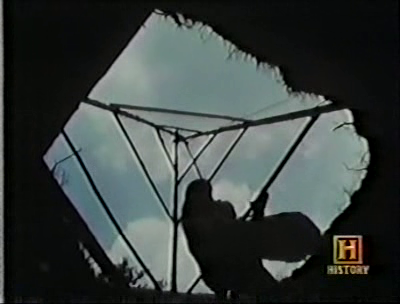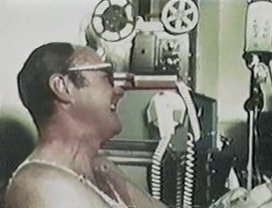In Search Of… S03E16 The Money Pit Mystery
Nimoy gives a truly wonderful narration at the beginning of this, all about lost treasure in a mysterious pit. The re-enactment of some boys digging the pit is cool, the music is perfect. It looks more like the opening to a late seventies kids TV movie. Nimoy tells us that in 1795, these kids dug a pit on Oak Island, Nova Scotia, in search of something buried there. In 1978, people were still digging. Sounds cool! Take it away, Money Pit Mystery!

Now, I know absolutely nothing about this mystery. I think I’ll forbear looking it up, because it sounds kind of awesome and I don’t want to be disappointed yet. We see footage of the island from the air and old timey-style maps as Nimoy tells us that in 1600s Nova Scotia was a haven for pirates. Doesn’t sound that unlikely. In the New World of the 1600s, the distinction between military, commercial and pirate vessels could be pretty thin.
Nimoy claims that people assume that the ‘brilliant buccaneer’ Captain Kidd buried his treasure on Oak Island. Ha, no. Kidd was an incompetent. Nimoy moves on to talking about Spanish gold or the lost French Crown Jewels. Whatever. There’s something valuable in a hole.
Standing in a wilderness area that almost certainly is almost certainly not in Nova Scotia, Nimoy tells stories of strange lights seen on the uninhabited Oak Island in the 1720s and how the island was believed to be haunted and dangerous.
We now see a recreation of three Canadian farm boys in 1795, rowing out to the island to search for treasure. They came to a tree with a sawn-off limb that extended over a depression in the ground. The boys naturally assumed pirate treasure and started digging. They found a ring of flagstones, a platform of log and pickaxe marks. The kids doing the reconstruction look like they’re having a whale of a time, by the way.
The boys left before dark and returned later. They found another layer of wood, which Nimoy claims was later carbon dated to the early 1500s. No treasure, though. The teenage reenactors vanish, replaced by adult reenactors. This is meant to be a few years later, after the boys convinced others of the importance of the pit, and a local doctor raised some money for a serious excavation. Every ten feet, they found another layer of wood, all the way down to 90 ft. There, they found a stone slab, inscribed with unfamiliar letters.
The re-enactment is really cool. They actually set up an old-timey wooden winch and they have oxen and such. Anyway, they find what seems like a vault. But when they go to breach it, they find that the pit has flooded.
You know what? I’m not even going to look this up. This is frickin’ awesome. You know what happens next? Guess. Go on, guess. The stone with the weird writing is decoded to say ’40 feet down, two million pounds are buried.’
I know, right?
This beats the crap out of Animal ESP, I tell you.
Next up is a charmingly cheap animation of the next attempt to get to the bottom of the Money Pit. Unable to pump out the water, they sent down a drill to take samples. Supposedly, they discovered wooden chests set in cement, and heard metal rattling. The reenactor’s drill comes up with three links of gold chain stuck to it. Evidence, Nimoy tells us, of ‘fantastic wealth.’
In 1850, the next set of reenactors get to work. 1978 was a good year to be a Nova Scotian extra. Anyway, they discover stone lined drainage channels, supposedly the reason why the water level in the Money Pit was tidal! Also, they find a mass of coconut fibre under the beach, acting as a sponge and keeping water coming into the channels. I don’t quite follow the mechanics of this, but still, it just keeps getting better.
In 1893, a photo of a guy improves on the animation, proving that the channels ran all the way from the beach to the pit. This is why it could not be pumped dry. He tried to block the channel with explosives, but an experiment proved that there were many more channels than expected. The entire island had been engineered to keep the pit flooded.
Ad break, and then a recap. Nimoy wonders if it’s Blackbeard’s treasure. Then he wonders if it was a stranded Spanish treasure ship, hiding its cargo. Marie Antoinette’s treasure? A search party in 1909 was pretty sure it was French crown jewels. The party included a young man named Franklin D. Roosevelt. But Nimoy says that it’s since been showed that the jewels remained in France. Sorry, young FDR. Hope your later projects turn out better.
On to 1937, and a millionaire from New Jersey found a treasure map in a book about Captain Kidd, that seemed to point to Oak Island. Having moved past the ‘age of reenactments’, we interview a guy who worked for this millionaire. He’s an old guy with a super cool accent who sits by the water and tells his story. He tells of finding a triangle of stones. A surveyor checks to see if this triangle lines up with the treasure map. It seemed to. We talk to the surveyor, who says that the triangle pointed at the Money Pit.
Then the author of the Kidd book came forward and said that he just made up the map.
Next we talk to Darcy O’Conner, a reporter from Montreal who is an expert on Oak Island. He talks about carbon dating on the wood from the pit and the coconut fibres. He says that whatever the Pit may be, it is no hoax.
The current owner of the island (which is private property) leans on the reconstructed old timey winch and tells of how his father drilled through some stone or concrete in the Money Pit and found a piece of parchment ‘no larger than a dime’. There may be a little writing on it. So treasure! Pit plus parchment equals treasure. It’s the law.
In the 1950s, a circus daredevil (!) leased treasure hunting rights on the island, and for the next six years he and his family tried to dig up the treasure. His wife talks about how they had no electricity or running water, but she was happy with how close to her family she was.
The daredevil, one of his sons and a couple of other workers, possibly knocked out by a buildup of carbon monoxide from a pump, fell into the Money Pit and drowned. The guy’s wife still lives near to Oak Island. She talks quite touchingly about learning of her husband’s death. She thinks that her husband thought he was pretty close, but she didn’t know if this was true.
After the accident, an industrial mining concern took over the lease. Nimoy claims that they were still looking in 1978, in spite of a local legend that one more must die.
We then get a nice little recap of the reenactments, and the whimsical old timey search for treasure is contrasted with the barren industrial wasteland left by the miners.
Almost certainly, if I look this up, I’ll find that there’s no evidence of treasure. That later searchers found no coconut fibres or that the stone lined tubes are questionable or whatever. You know what? I don’t care. Just for once, I’m going to enjoy the weird mystery. Crazy Jacobean engineering project that almost certainly would have cost more money than you could carry. What the hell, I give up. Why not?
Summing Up
Awesomeness: 10/10, Nimoyness: 10/10, Music: 10/10, Reenactments: 9/10, Awsomeness again: 10/10. Overall: 49/50. High Distinction



